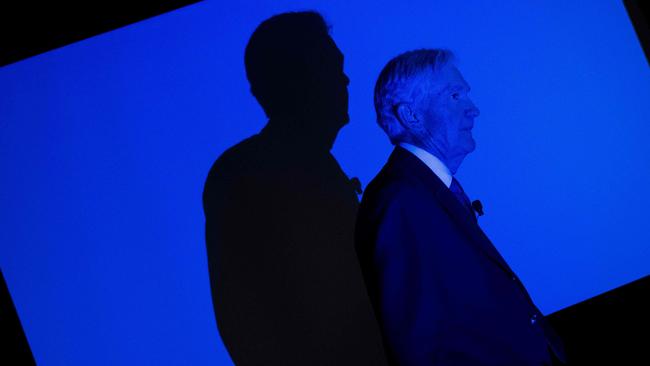
This week, the S&P 500 recorded a historic day, on Tuesday the key Wall Street index’s intraday swing marked the first time since at least 1978 the benchmark hit an intraday high up more than 4 per cent – only to close down more than 1 per cent. And the Nasdaq blew its biggest intraday gain since at least 1982.
We are still early in this whole tariff saga, and its fallout will take time to unfold. A US recession looms as a growing possibility. However, unlike the past 15 years where Covid (a fleeting shock) and the Global Financial Crisis were met with rapid and massive policy intervention, companies today may be unprepared for a systemic shift in the global playing field.

During the GFC, today’s tech giants — those which have led the market higher — were much smaller entities penetrating new markets with long runways of rapid growth ahead. Today, with their growth rates slowing, it’s no wonder investors have recalibrated their willingness to pay steep price-earnings multiples even for the best and most liquid names.
The aggregate PE ratio for the Magnificent Seven has compressed by a third, from nearly 32 times earnings last year to just 22 times earnings. Meanwhile, no one other than Donald Trump knows where all the tariffs, reciprocal or otherwise, will land.
Even those designing the new global system seem to be at odds with what their leader is doing.
During the week, Treasury Secretary Scott Bessent inspired a huge intraday rally in markets when he said the Trump administration was open to negotiating to reduce tariffs. But later the same day, Trade Representative Jamieson Greer said Mr Trump would not provide exemptions to his global tariffs. Stocks slumped.
Beijing appears to be digging in for a protracted battle. China, facing tariffs now at 145 per cent, vowed to “fight to the end,” devaluing the yuan and propping up its stockmarket, signalling a prolonged standoff.
And then there’s the spectre of stagflation raised by the tariffs. Stagflation is a simultaneous slump in growth and surging inflation. Back in 1974, when the oil shock caused inflation to spike to 12 per cent, a dilemma was presented: if the Fed tightened its policy by increasing rates, it would further slow a waning economy. If it did nothing, or lowered rates, to boost production inflation would spiral out of control.
Fix one problem, and something else breaks. Finally, a choice was made. Then Federal Reserve chair Paul Volcker engineered two massive but brief recessions by raising the interest rate to 20 per cent. When he left office in 1987, inflation had sunk to 3.4 per cent from its peak of 9.8 per cent.

But in addition to the economic malaise, there was another cost, and Warren Buffett famously highlighted this. Between 1964 and 1981, the stockmarket went nowhere. After 17 years, the Dow Jones was a mere one point higher in 1981 than it was in 1964.
Are Mr Trump’s tariffs the “oil shock” of 2025? Time will tell. But what if all of the tariffs and PE deratings are just a sideshow? What if the real issue for markets is a necessary unwinding of American exceptionalism?
Since the GFC, the US government, Treasury and central bank avoided recession by kicking the can down the road through quantitative easing, fiscal deficits, and dovish central bank settings.
One can argue the consequent equity market boom reflected not fundamental quality and organic growth amid intense competition which makes businesses better and more efficient, but a wave of unprecedented financial support masking weaker fundamentals.
US budget deficits hit 7 per cent of GDP but, curiously, the country was not fighting a war or in deep recession.
Mr Trump would now like to bring deficits back to 3 per cent of GDP. Can we expect equity markets to boom, as they have in the past, if the fiscal spigot — a source of the prior boom — is turned off?
Some commentators suggest cracks are already showing, with recent volatility and tariffs potentially signalling a tectonic shift. Mr Trump’s tariff escalation could reflect and seek to reverse decades of wage stagnation, inequality, and middle-class erosion — symptoms of neoliberal self-aggrandisement and mismanagement.
A trade war is undesirable, but what if this isn’t just a trade war? What if it’s a fracture in the global financial order? One reassuring certainty is this: if you buy shares in a company growing earnings per share at double-digit rates, your annual return will equal the earnings per share growth rate provided you buy and sell the shares on the same PE ratio.
This compels you to invest in growth, and to invest when the PE ratio is low. Thus, if the PE ratio remains low, and stocks remain unpopular, you can still collect a double-digit return.
So, after years of quick recoveries and central bank rescues, investors now need to be more discerning. Indeed, we may be returning to a period where traditional investment management and conventional investment thinking — patiently waiting for high-quality names to succumb to fear and thus enabling the “locking-in” of low PE multiples as well as attractive future returns — works. And that’s something we should all be looking forward to.
Roger Montgomery is founder and chief investment officer at Montgomery Investment Management






It seems like a distant memory now, but 2025 began with an upbeat outlook, buoyed by deregulation and robust earnings. By February, however, the mood shifted as the US released a significant trade policy document, hinting at a tough stance towards its trading partners.